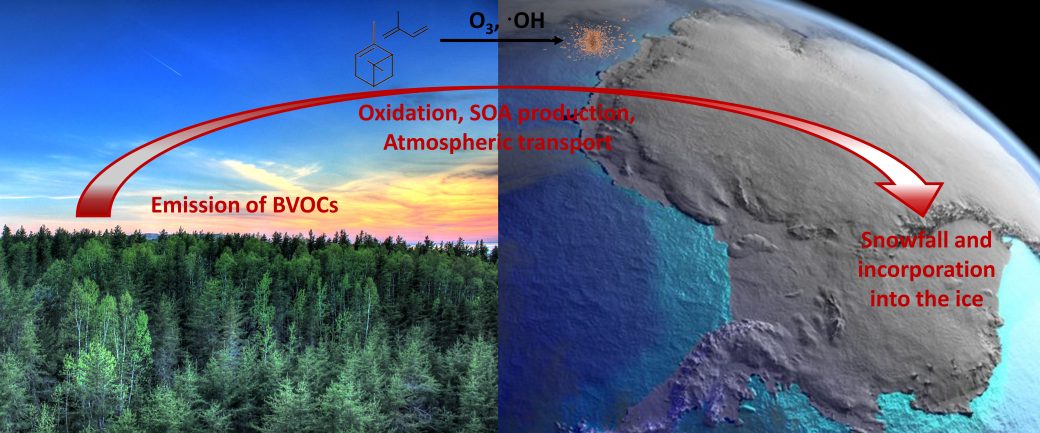
Lead supervisor: Chiara Giorio, Chemistry
Co-supervisor: Liz Thomas, British Antarctic Survey
Brief summary:
This project will assess the use of biogenic organic markers in Antarctic ice cores to reconstruct past changes in the marine and terrestrial biosphere.
Importance of the area of research concerned:
Ice-core measurements of long-lived gases and many inorganic compounds have provided environmental information on the past atmosphere, but it has been recognised that important additional climatic information resides in the organic compounds which are also present [1].
The terrestrial biosphere is by far the largest emitter of both primary organic aerosols and volatile organic compounds (VOCs) into the Earth’s atmosphere [1, 2]. Biogenic VOCs (BVOCs), such as isoprene and monoterpenes, get transformed into more stable compounds by atmospheric oxidants during their atmospheric lifetime and transport to the polar regions, and form secondary organic aerosol (SOA). Once incorporated in aerosol particles these compounds are more stable against oxidation and have lifetimes comparable with transport times to polar regions. Most BVOCs are emitted by both the terrestrial and marine biospheres, their concentrations in Antarctic ice cores can provide information on the past composition of both biospheres, their emission strength, and environmental conditions at the time of atmospheric transport before incorporation into the ice.
Project summary :
The aim of the project is to apportion the contribution of terrestrial and marine biospheres to the concentration of BVOC oxidation products in Antarctic ice cores. A selection of ice cores taken from different regions in Antarctica, close and far from the coast, will be analysed for quantification of the oxidation products of isoprene, α- and β-pinene using a newly developed analytical method using an ultrahigh performance liquid chromatography quadrupole tandem linear ion trap (UHPLC-QTRAP®, AB Sciex 5500+) mass spectrometer. The data will be evaluated against other species measured routinely in the ice samples. The datasets, obtained from different ice cores, will be analysed with Positive Matrix Factorisation [3] to apportion the contribution of terrestrial and marine sources to the organic biomarkers.
What will the student do?:
The student will be based at the Department of Chemistry, where the supervisory team will assist the student in familiarising with quantitative analysis of organic compounds in ice cores. The analytical work may include optimisation and validation to reach the maximum instrumental performances and ensure adequate detection limits. The student will also be involved in laboratory campaigns at the British Antarctic Survey (BAS), for sample collection and analyse using the continuous flow analysis system during melting of new ice cores. The student will also work in the -20 cold laboratories and a class-100 cleanroom at BAS. The project is not dependent on the collection of new ice cores; however, we endeavour to include the student in future drilling projects. The student will have a chance to interact with an international network of collaborations and to present the results in national and international conferences.
References - references should provide further reading about the project:
Giorio, C., Kehrwald, N., Barbante, C., Kalberer, M., King, A.C.F., Thomas, E.R., Wolff, E.W., & Zennaro, P. 2018. Prospects for reconstructing paleoenvironmental conditions from organic compounds in polar snow and ice. Quaternary Science Review, vol. 183, pp. 1–22., DOI: 10.1016/j.quascirev.2018.01.007
Laothawornkitkul J, Taylor JE, Paul ND, Hewitt CN (2009) Biogenic volatile organic compounds in the Earth system. New Phytol 183:27–51 . https://doi.org/10.1111/j.1469- 8137.2009.02859.x
Giorio C, Tapparo A, Dall’Osto M, Beddows DCS, Esser-Gietl J, Healy RM, Harrison RM (2015) Local and regional components of aerosol in a heavily trafficked street canyon in central London derived from PMF and cluster analysis of single particle ATOFMS spectra. Environ Sci Technol 39:3330–3340. https://doi.org/10.1021/es506249z
Applying
You can find out about applying for this project on the Department of Chemistry page.